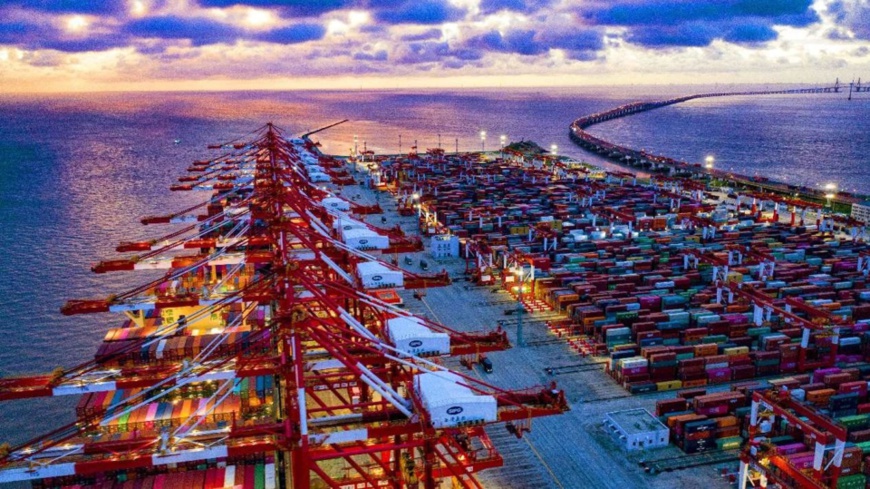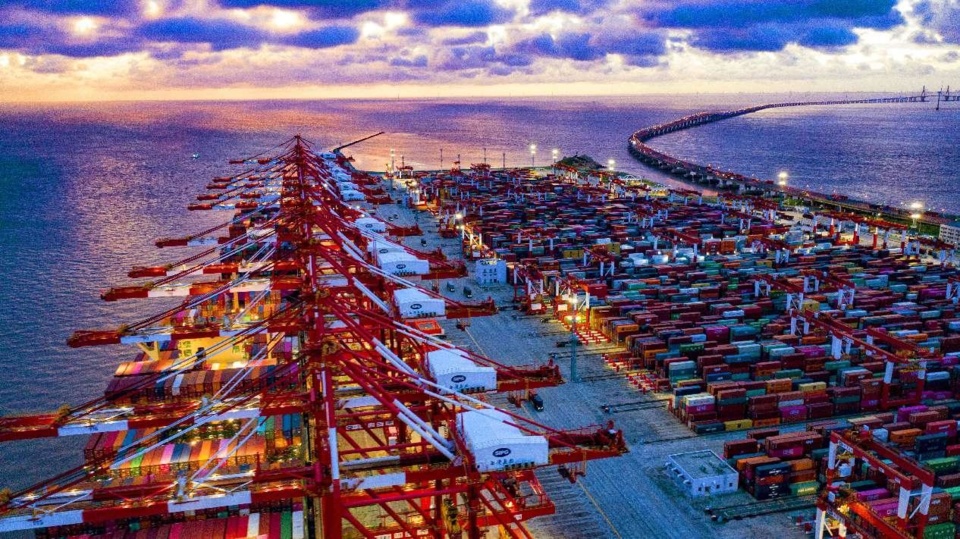By Liu Shi'an, Xie Weiqun, People's Daily

Freighters are being loaded and unloaded at a terminal of the Yangshan port in the Port of Shanghai, Sept. 11, 2021. (Photo by Ji Haixin/People's Daily Online)
Yangshan deep-water port, as a part of the Port of Shanghai, is a witnesses to China's firm steps of opening up. As a major hub for international shipping, the small port carries huge energy.
The container throughput of the Port of Shanghai exceeded 47 million 20-foot equivalent units in 2021, ranking first globally for 12 consecutive years, and nearly half of these containers were handled by the Yangshan port.
Besides, the Port of Shanghai has over 300 international sea routes, and more than 80 of them start from the Yangshan port, which are mostly ocean-going lines.
In 1990s, China's foreign trade was surging due to accelerated opening up. At that time, most of the ports in Shanghai were on the southern bank of the Yangtze River estuary and along the Huangpu River, where there was no deep-water berth for heavy-load vessels to dock at. Therefore, to build a deep-water port was put on the agenda of Shanghai in 1995.
After China was admitted to the WTO in Dec. 2001, the construction of the Yangshan port officially commenced in the following year. By the end of 2005, the first phase of the port had been put into use.
The Port of Shanghai ranked first in the world in terms of container throughput soon after the operation of the Yangshan port. Thanks to the implementation of major national strategies, such as the Belt and Road Initiative, the construction of pilot free trade zones and the Yangtze River economic belt, the throughput of the Yangshan port has been making records every year. With a continuously growing ratio of transshipment, the Yangshan port has gradually gained the status as a global hub.
On Dec. 10, 2017, the fourth phase of the Yangshan Port started trial operation. As the world's largest automated container terminal, the project is also called an "unmanned terminal," which is able to run 24 hours a day.
Last year, when the ravaging COVID-19 pandemic still had a huge impact on international shipping industry, the Yangshan port bucked the trend and reported 12.8 percent growth in throughput, which laid a solid foundation for the 8.1 percent growth achieved by the Port of Shanghai.
When international shipping orders were severely hindered and businesses of major ports around the world remained stagnant, the Yangshan port kept running and became a vital hub for global shipping thanks to the positive results of China's pandemic control.
"Normally the Port of Shanghai sees 1,200 regular international freighters each month. However, some trunk-line freighters have been made unpunctual as other international ports were seized up. Therefore, we made proper adjustment based on our prediction and analysis to ensure orderly arrival of vessels," said Yang Yanbin, deputy general manager of the production department of the Shanghai International Port (Group) Co., Ltd. (SIPG).
During the past year, many freighter companies have rescheduled their international routes, taking the Yangshan port as a transfer center.
To better handle the situation, the SIPG is accelerating the development of information and intelligent technologies. Through virtual reality, digital twin and other new technologies, the group has built an intelligent center for joint emergency dispatching and a digital platform for port production to control the port with higher efficiency. Besides, the port is also connected to marine meteorological and tide data.
The container throughput of the Port of Shanghai exceeded 47 million 20-foot equivalent units in 2021, ranking first globally for 12 consecutive years, and nearly half of these containers were handled by the Yangshan port.
Besides, the Port of Shanghai has over 300 international sea routes, and more than 80 of them start from the Yangshan port, which are mostly ocean-going lines.
In 1990s, China's foreign trade was surging due to accelerated opening up. At that time, most of the ports in Shanghai were on the southern bank of the Yangtze River estuary and along the Huangpu River, where there was no deep-water berth for heavy-load vessels to dock at. Therefore, to build a deep-water port was put on the agenda of Shanghai in 1995.
After China was admitted to the WTO in Dec. 2001, the construction of the Yangshan port officially commenced in the following year. By the end of 2005, the first phase of the port had been put into use.
The Port of Shanghai ranked first in the world in terms of container throughput soon after the operation of the Yangshan port. Thanks to the implementation of major national strategies, such as the Belt and Road Initiative, the construction of pilot free trade zones and the Yangtze River economic belt, the throughput of the Yangshan port has been making records every year. With a continuously growing ratio of transshipment, the Yangshan port has gradually gained the status as a global hub.
On Dec. 10, 2017, the fourth phase of the Yangshan Port started trial operation. As the world's largest automated container terminal, the project is also called an "unmanned terminal," which is able to run 24 hours a day.
Last year, when the ravaging COVID-19 pandemic still had a huge impact on international shipping industry, the Yangshan port bucked the trend and reported 12.8 percent growth in throughput, which laid a solid foundation for the 8.1 percent growth achieved by the Port of Shanghai.
When international shipping orders were severely hindered and businesses of major ports around the world remained stagnant, the Yangshan port kept running and became a vital hub for global shipping thanks to the positive results of China's pandemic control.
"Normally the Port of Shanghai sees 1,200 regular international freighters each month. However, some trunk-line freighters have been made unpunctual as other international ports were seized up. Therefore, we made proper adjustment based on our prediction and analysis to ensure orderly arrival of vessels," said Yang Yanbin, deputy general manager of the production department of the Shanghai International Port (Group) Co., Ltd. (SIPG).
During the past year, many freighter companies have rescheduled their international routes, taking the Yangshan port as a transfer center.
To better handle the situation, the SIPG is accelerating the development of information and intelligent technologies. Through virtual reality, digital twin and other new technologies, the group has built an intelligent center for joint emergency dispatching and a digital platform for port production to control the port with higher efficiency. Besides, the port is also connected to marine meteorological and tide data.
 Menu
Menu
 Yangshan port in Shanghai strives to build world-class terminals
Yangshan port in Shanghai strives to build world-class terminals
















